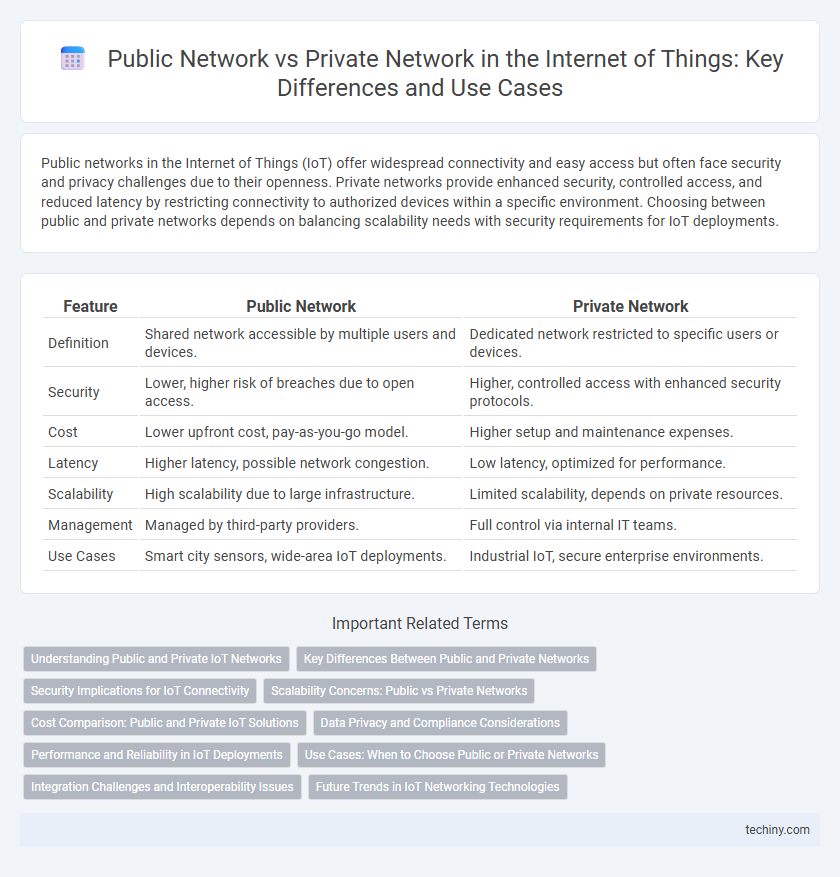Public networks in the Internet of Things (IoT) offer widespread connectivity and easy access but often face security and privacy challenges due to their openness. Private networks provide enhanced security, controlled access, and reduced latency by restricting connectivity to authorized devices within a specific environment. Choosing between public and private networks depends on balancing scalability needs with security requirements for IoT deployments.
Table of Comparison
| Feature | Public Network | Private Network |
|---|---|---|
| Definition | Shared network accessible by multiple users and devices. | Dedicated network restricted to specific users or devices. |
| Security | Lower, higher risk of breaches due to open access. | Higher, controlled access with enhanced security protocols. |
| Cost | Lower upfront cost, pay-as-you-go model. | Higher setup and maintenance expenses. |
| Latency | Higher latency, possible network congestion. | Low latency, optimized for performance. |
| Scalability | High scalability due to large infrastructure. | Limited scalability, depends on private resources. |
| Management | Managed by third-party providers. | Full control via internal IT teams. |
| Use Cases | Smart city sensors, wide-area IoT deployments. | Industrial IoT, secure enterprise environments. |
Understanding Public and Private IoT Networks
Public IoT networks use wide-area connectivity like cellular or LPWAN to enable large-scale device communication across diverse locations, ensuring broad accessibility and scalability. Private IoT networks leverage localized infrastructure such as Wi-Fi, Zigbee, or private LTE to provide enhanced security, lower latency, and greater control over data flows tailored to specific enterprise or industrial environments. Choosing between public and private networks depends on factors like coverage requirements, security policies, cost constraints, and the criticality of real-time data processing in IoT deployments.
Key Differences Between Public and Private Networks
Public networks in the Internet of Things (IoT) provide widespread accessibility, enabling devices to connect over a shared infrastructure like the global internet, which offers extensive scalability but limited control over security and data privacy. Private networks, by contrast, restrict access to a dedicated infrastructure often controlled by a single organization, enhancing security, reliability, and tailored performance for critical IoT applications. Key differences include control over data traffic, security protocols, latency, and the ability to customize network configurations to meet specific operational requirements.
Security Implications for IoT Connectivity
Public networks expose IoT devices to higher security risks such as unauthorized access, data interception, and cyberattacks due to their open nature and shared infrastructure. Private networks offer enhanced security through controlled access, encrypted communication, and dedicated resources, reducing vulnerabilities in IoT connectivity. Implementing private network architectures like VPNs, MPLS, or 5G standalone networks significantly mitigates threats and ensures robust protection for sensitive IoT data and devices.
Scalability Concerns: Public vs Private Networks
Public networks offer extensive scalability for IoT deployments by leveraging existing infrastructure and wide-area connectivity, supporting millions of devices across diverse locations. Private networks provide controlled scalability tailored to specific enterprise needs, often utilizing localized resources to ensure low latency and enhanced security. Balancing scalability with security and performance requirements is critical when choosing between public and private IoT network architectures.
Cost Comparison: Public and Private IoT Solutions
Public IoT networks typically offer lower upfront costs due to shared infrastructure, reducing expenses related to hardware deployment and maintenance. Private IoT networks incur higher initial investments as they require dedicated hardware, customized security, and ongoing management but provide enhanced control and reliability. Total Cost of Ownership (TCO) analyses often show public networks are cost-effective for large-scale, low-security applications, while private networks are more economical long-term for sensitive or mission-critical environments.
Data Privacy and Compliance Considerations
Private networks in the Internet of Things (IoT) provide enhanced data privacy by restricting access to authorized devices and users, reducing exposure to external threats compared to public networks. Compliance with regulations such as GDPR and HIPAA is more manageable in private networks due to controlled data flow and customizable security protocols. Public networks increase vulnerability risks and complicate adherence to data protection standards, necessitating advanced encryption and continuous monitoring to maintain compliance.
Performance and Reliability in IoT Deployments
Public networks offer broad coverage but can suffer from variable latency and congestion, impacting IoT device performance and data transmission reliability. Private networks ensure enhanced control over bandwidth allocation and security protocols, resulting in consistent low-latency connections and higher uptime critical for mission-critical IoT applications. Deployments using private networks benefit from dedicated resources that minimize interference and optimize real-time data exchange essential for industrial and healthcare IoT systems.
Use Cases: When to Choose Public or Private Networks
Public networks suit IoT use cases requiring wide coverage and cost efficiency, such as smart city sensors and asset tracking across large geographic areas. Private networks are ideal for industrial IoT applications demanding high security, low latency, and reliable connectivity, including manufacturing automation and critical infrastructure monitoring. Choosing between public and private networks depends on factors like data sensitivity, network performance requirements, and scalability needs.
Integration Challenges and Interoperability Issues
Public networks in Internet of Things (IoT) environments often face integration challenges due to diverse protocols and varying security standards, which can hinder seamless data exchange and device compatibility. Private networks offer controlled environments that improve interoperability by standardizing communication protocols and enabling custom security measures tailored to specific industrial or enterprise needs. However, the complexity of integrating legacy systems with cutting-edge IoT devices in private networks still demands robust middleware solutions to bridge compatibility gaps.
Future Trends in IoT Networking Technologies
Future trends in IoT networking emphasize the expansion of private networks utilizing 5G and edge computing to enhance security, reduce latency, and increase device autonomy. Public networks continue to evolve with improvements in LPWAN technologies such as NB-IoT and LTE-M, supporting massive IoT deployments over wide areas. Hybrid network architectures combining public and private components are becoming prominent to optimize scalability, reliability, and data privacy for diverse IoT applications.
public network vs private network Infographic

 techiny.com
techiny.com